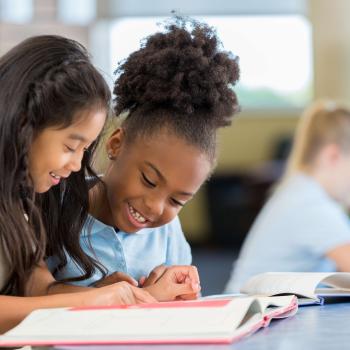This lesson employs direct instruction and small-group discussion to help students learn new vocabulary skills while reading Patricia Polacco's Pink and Say.

Acquiring New Vocabulary Through Book Discussion Groups

Grades
|
Using Prediction as a Prereading Strategy
3 - 5
Lesson Plan
| Standard Lesson
Students learn about and apply the prediction strategy while reading a trade book. They use response journals to record questions and responses based on prereading predictions.

Grades
|
Using the Check and Line Method to Enhance Reading Comprehension
6 - 8
Lesson Plan
| Minilesson
Do your students skim assigned text material without even engaging their brains? The Check and Line method encourages students to think about what they are reading and monitor their own comprehension of the information.

Grades
|
Whole-to-Parts Phonics Instruction: Teaching Letter-Sound Correspondences
K - 2
Lesson Plan
| Standard Lesson
Students will find that learning onset and rime is a handy skill when they read the Jack and Jill rhyme.

Grades
|
Cowboys and Castles: Interacting With Fractured Texas Tales
K - 2
Lesson Plan
| Standard Lesson
What do cowboy hats have to do with fairy tales? Two traditional fairy tales and their Texas-based counterparts set the stage for five different ways to respond to text.

Grades
|
Poetry Portfolios: Using Poetry to Teach Reading
K - 2
Lesson Plan
| Standard Lesson
Teach your students about sentence structure, rhyming words, sight words, vocabulary, and print concepts using a weekly poem.

Grades
|
QARs + Tables = Successful Comprehension of Math Word Problems
3 - 5
Lesson Plan
| Standard Lesson
Using census data for an example, students use the question-answer relationship (QAR) strategy to understand and solve word problems that refer to tables and other graphics.

Grades
|
Word Wizards: Students Making Words
K - 2
Lesson Plan
| Minilesson
The Word Wizard activities in this lesson transform phonics from drudgery into delight! Students manipulate letters to make different words.

Grades
|
Lights, Camera, Action: Interviewing a Book Character
6 - 8
Lesson Plan
| Unit
Students get the inside scoop on a story when they create interview questions and answers for characters in the books they read.

Grades
|
Building Reading Comprehension Through Think-Alouds
6 - 8
Lesson Plan
| Standard Lesson
Students learn components of think-alouds and type-of-text interactions through teacher modeling. In the process, students develop the ability to use think-alouds to aid in reading comprehension tasks.

Grades
|
A is for Apple: Building Letter-Recognition Fluency
K - 2
Lesson Plan
| Standard Lesson
Students apply and build their knowledge of letters and letter sounds as they play games and interact with letters online, creating their own ABC book as a final activity.

Grades
|
Using a Predictable Text to Teach High-Frequency Words
K - 2
Lesson Plan
| Standard Lesson
After reading an engaging yet predictable text about a child looking for his cat, students use a similar format and high-frequency words to craft tales about their own lost pets.

Grades
|
Creative Writing Through Wordless Picture Books
6 - 8
Lesson Plan
| Standard Lesson
Students are exposed to wordless picture books and begin developing story lines, both orally and in writing, using an online, interactive story map.

Grades
|
Alaska Native Stories: Using Narrative to Introduce Expository Text
3 - 5
Lesson Plan
| Standard Lesson
Tradition and technology come together in this lesson in which students learn about Alaskan animals through Native American tales and their own online research.

Grades
|
Fighting Injustice by Studying Lessons of the Past
6 - 8
Lesson Plan
| Unit
Social injustice occurs every day all over the world. In this lesson, students research a few historical examples of social injustice, including the Holocaust, the Trail of Tears, and Japanese internment.

Grades
|
Generating Rhymes: Developing Phonemic Awareness
K - 2
Lesson Plan
| Standard Lesson
Traditional chants and songs are adapted to help young students recognize and generate rhymes. The word and letter patterns involved in rhymes provide a stepping stone to reading skills.

Grades
|
Building Phonemic Awareness With Phoneme Isolation
K - 2
Lesson Plan
| Recurring Lesson
Students improve phonemic awareness through games and chants that help them isolate beginning and ending sounds and connect them with their written symbols (graphemes).

Grades
|
Multimedia Responses to Content Area Topics Using Fact-"Faction"-Fiction
3 - 5
Lesson Plan
| Standard Lesson
Students climb into the mind of a spider in this lesson that asks them to compose a spider diary using spider facts, fiction, and "faction"fiction that sounds like fact.

Grades
|
Gingerbread Phonics
K - 2
Lesson Plan
| Standard Lesson
"Run, run, as fast as you can." Students use this refrain from The Gingerbread Man to learn letter-sound correspondence. Students use their new skills to write an online story.

Grades
|
Using THIEVES to Preview Nonfiction Texts
6 - 8
Lesson Plan
| Standard Lesson
Students become "thieves" in this lesson as they use a previewing strategy to "steal" information from textbooks and other nonfiction texts before actually reading them.